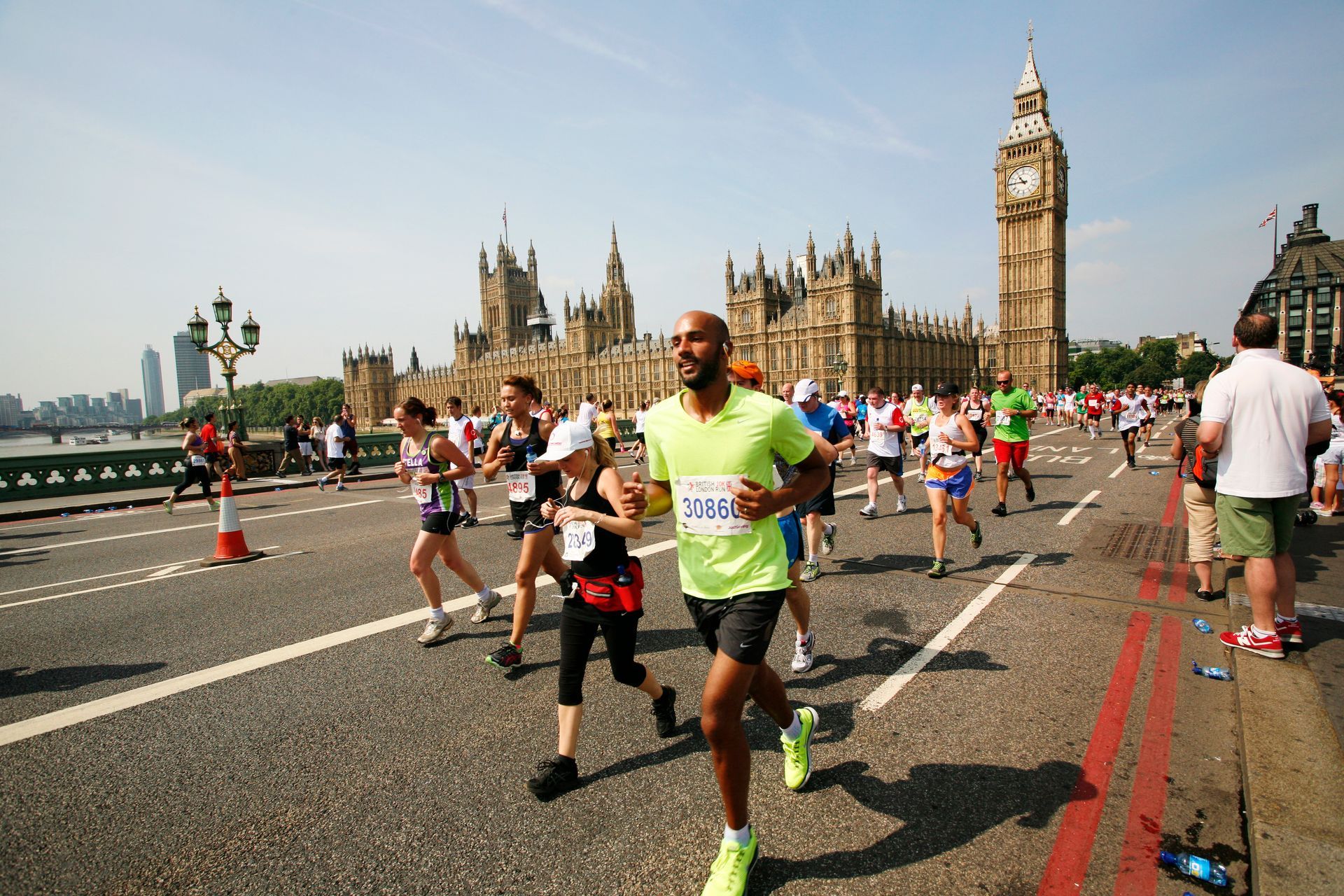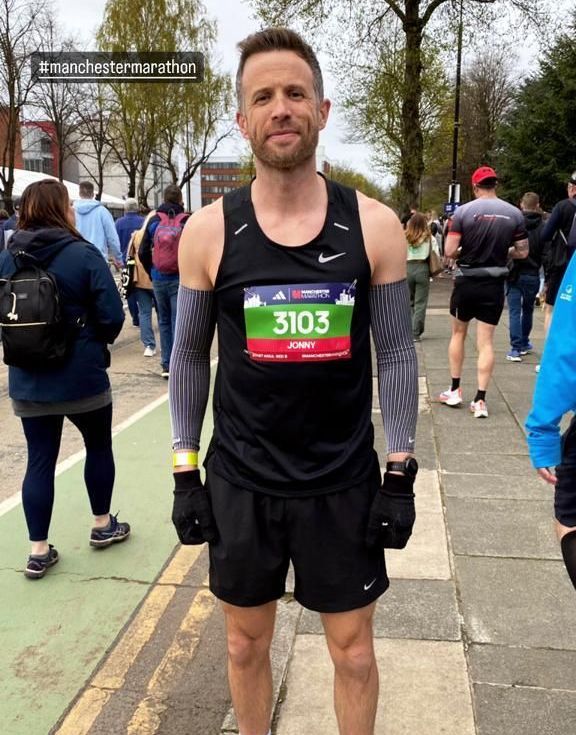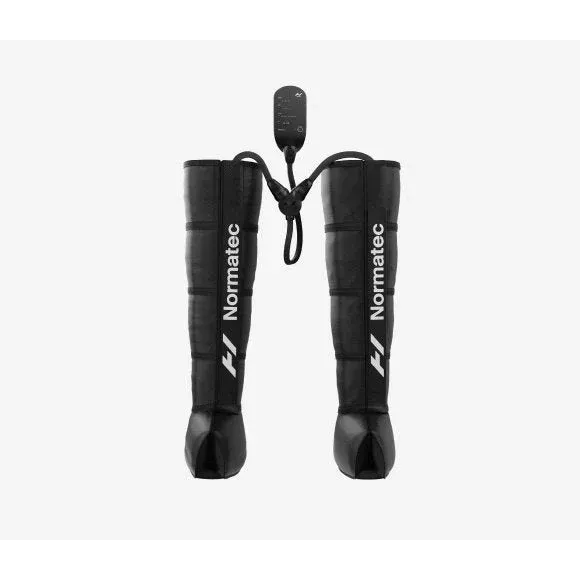My Marathon Story (Jon McComish) - Chelmsford Physio
I really enjoyed watching the London Marathon on Sunday. One of the best sporting events
of the year, and something that means so much to so many. More than 45,000 runners,
each with their own story, motivation and reason for running. From the 23 year old Kenyan,
Kelvin Kiptum making history in the men’s race smashing the course record and finishing
with the second fastest marathon time in history. To Sifan Hassan winning the female race
in her debut marathon despite stopping twice for a stretch, then nearly getting run over by
a support motorbike when she ran off for a drinks bottle. Incredible stuff!
I was sitting at home yesterday, refreshing the London Marathon app, following the
progress of a list of clients and friends on their race. Thankfully every one of them finished,
and with some seriously impressive times.

One week previously, I was running my own marathon in Manchester. I had decided to run
it during the summer of 2022, and I put a 5-6 month training plan in place.
I’ve always run, but mainly for sports like football. For me I enjoy exercise and keeping fit, so
I’ve always tried to maintain fitness to run between 5-10k.
In March of 2013 I ran the Colchester half marathon and then in the April I ran the Brighton
full marathon. Since then I played football and might run the occasional 5k or 10K. During
lockdown I decided to stop playing football and to run more regularly myself. I also enjoy
cycling, and decided to mix the week by alternating between running days and cycling days.
Off the back of lockdown and the new training regime, I decided to challenge myself with
the Chelmsford Half marathon in March 2022. This went better than expected and once I
recovered fully I decided to give the marathon one more go.
Most people reading this will understand and appreciate how difficult it is to get into the
London Marathon through the ballot. I think I’ve tried numerous times over the years and
been unsuccessful each time.
So after missing out on the London Marathon, I looked at other options and the Manchester
Marathon had been recommended and sounded like a good option for me. I signed up
towards the end of the summer and tried to maintain 3 steady runs a week, and some
strength work in the gym. I decided to start a training plan 5-6 months in advance of the
marathon, that meant having a program in place from November. I reached out to a physio
friend, who specialises in running and we discussed a plan. My original goal was to run a sub
3.05 hour marathon, which is a time for my age. As the training got going, we decided a
sub 3 hour marathon was a better goal and we worked on a training plan/program to
achieve that.

My training plan was fitted around my work and home life, to make the sessions easier to
achieve.
My training plan looked like this:
Monday – 40min recovery run & strength to fit around work 12-8pm
Tuesday – rest day, due to work and kids swimming after work
Wednesday – Intervals in the afternoon, after work 8-2pm
Thursday – 40min recovery run & strength to fit around work 10am-6pm
Friday – long run, to fit with working from home day
Saturday – rest day, as busy family day
Sunday – Tempo run in the morning
This plan really worked for me, and I think I only missed one run in four months training.
My weekly plan consisted of five runs and two strength sessions. We used minutes not miles
for all the sessions.
Minutes not Miles
Using minutes not miles to plan your training can be more helpful, than using distance and
pace. It’s simple and easy to plan, using minutes when we are building up our running in
terms of volume and intensity. We aim to build up to the total time on feet when running
and the intensity of some of the sessions. This allows us to progress training sensibly, and
reduce the risk for injury. When we run for distance the emphasis often becomes about
getting the distance done/covered as quickly as we can, and as a result the pace can
increase, and the intensity follows.
By taking away the distance element, the emphasis shifts away from how long it takes to
run that distance and so allows us to control the intensity of the session better.
80:20 training
Another helpful metric is heart-rate (HR), if you know it or you can work out your max HR
you can then monitor training zones. The 80:20 rule, this is widely used by elite level
runners and refers to 80% of your training being completed at a low intensity, and 20% of
your running being completed at a moderate to high intensity. Too much high intensity
running doesn’t allow for sufficient recovery and therefore is an injury risk.
Another helpful tool is (RPE) Rate of Perceived Exertion, below is a table on how RPE works.
80% of marathon training should be completed at a low intensity (RPE 4 or below), with the
other 20% being performed at moderate to high intensity (RPE 6 & above).

Recovery
A pillar of any training program is recovery, and not prioritising this will increase your risk of
injury and can detract from your performance. 50% of training should be recovery.
Prioritising sleep was really important to me and my training. Less than 7 hours sleep a
night, can double your risk of injury. I tried to aim for 8 hours sleep every night, and used my
watch to monitor my sleep and my HR.
Another tool I used was Normatec Recovery boots. I would wear these on as many evenings
as possible, especially after any tough sessions that day. I would put my feet up on the sofa,
put the Normatecs on level 8-10 and let them do their thing for 45-60mins. The next
morning was always easier after using them.

Stretching and Strengthening
There is good evidence to suggest that elite endurance runners are less flexible than their
non-elite counterparts (Baxter et al, 2017).
However, when you run impact forces are typically 2-3 times your body weight on every
stride. These forces pass through your joints, muscles and tendons. For example, if you
weight 60Kg and runs at 6.30min/mile pace (1072 strides), with impact forces at least x2
body weight (120kg x563) = 64320/64.32 tonnes per foot per mile!!
In my training I didn’t perform any static stretching. I did perform some mobility drills on a
regular basis. I’m lucky to work at Riverside Leisure Centre, where there is a fantastic gym
which I could access to perform my weekly strength program. This really helped me and I
had a few small niggles but never had an injury throughout the process.
Nutrition
This isn’t an area I claim to know lots about, so I contacted a friend who specialises in this
and helped me fit a nutrition plan around me. I learned early in my training what my body
like and responded to, and I stuck to that throughout my training and on the race day.
The five month training block had gone exactly to plan. I ran the Essex 20 (20 miler) in
preparation and I felt great. It gave me the race day preparation, so a good rehearsal for the
marathon day. It also gave me the confidence I could run the pace I wanted for in excess of
20 miles.
Taper
A good marathon taper can make up around 5% increase in your finishing time. A taper
period normally starts the day after your last long run and you gradually start cutting back
on your training distance and effort. A marathon can be specific to each runner, and ideally
should be individualised.
This is where things started to go wrong for me. Nothing to do with the taper or planning,
but there are some things you can’t control in life. I developed a chest infection 1 week out
from the marathon race day, which couldn’t be much worse in terms of timing.
I got to see a GP, who prescribed some antibiotics which I took from the Monday to Friday.
I also needed to take inhalers 3-4 times a day to relieve the symptoms.
Then on the Tuesday my Gran in Ireland passed away, and the funeral was planned for the
Saturday. I considered cancelling the marathon, but after chatting with my wife, and my
family I thought I would go ahead with it and I planned my flights home to Ireland for the
Friday morning and then direct from Dublin to Manchester on the Saturday night.
My wife met me in Manchester on the Saturday night and we checked into the hotel and
got some sleep.
Race Day
I didn’t feel anywhere near 100% on the day of the marathon, but I thought I would see how I
feel as the race progresses. My training had me on for a sub 3hr race, but time would tell.
The setup at Manchester was fantastic, everything was so easy. The start and the end of the
race was from Old Trafford, the bag drop area was slick. I was warmed up and all ready for
my 9.20am start.

My plan was to run with the 3hr pacer and see how I felt, I decided to follow my HR as a
guide, rather than my pace. The first hour didn’t feel great, my HR was probably 20 beats
higher than it should’ve been, and it felt tough, much tougher than the Essex 20 one month
earlier. The second hour didn’t get too much harder, I managed to find a rhythm and stayed
close to the 3hr pacer whilst monitoring my HR.
The last hour just got tougher and tougher, and I struggled to stay with the 3hr pacer from
mile 23 onwards. I ran the last 2-3 miles on my own, and I won’t lie, it was tough going and
would’ve been easy to stop and walk. I just kept thinking about all the training I had done,
and how much effort my wife made to come to Manchester and support me.
I gave it everything on the day and finished in 3hrs and 1min, so close and a great time all
things considered. This time hopefully gives me a place in the London marathon next year.
If I’m honest I really enjoy the process, and it’s probably more about the process for me
than the race itself.

I decided to write this to reflect on the process and answer some of the questions I regularly
get asked in clinic every week. On reflection, I’m so glad I didn’t pull out and I don’t have
any regrets from the training. Looking back to my first and only other marathon in 2013, I
finished in 3hrs and 24mins, and I didn’t enjoy the race at all. If I’m honest my training
wasn’t smart, I didn’t plan it very well and I struggled on the day. I’ve highlighted the key
parts of the training that I have learned from and improved on over the 10 years.
I hope it is of help to some of you reading and if you would like any further information, just
let me know.
Chelmsford Physio
Riverside Leisure Centre, Victoria Rd, Chelmsford CM1 1FG



